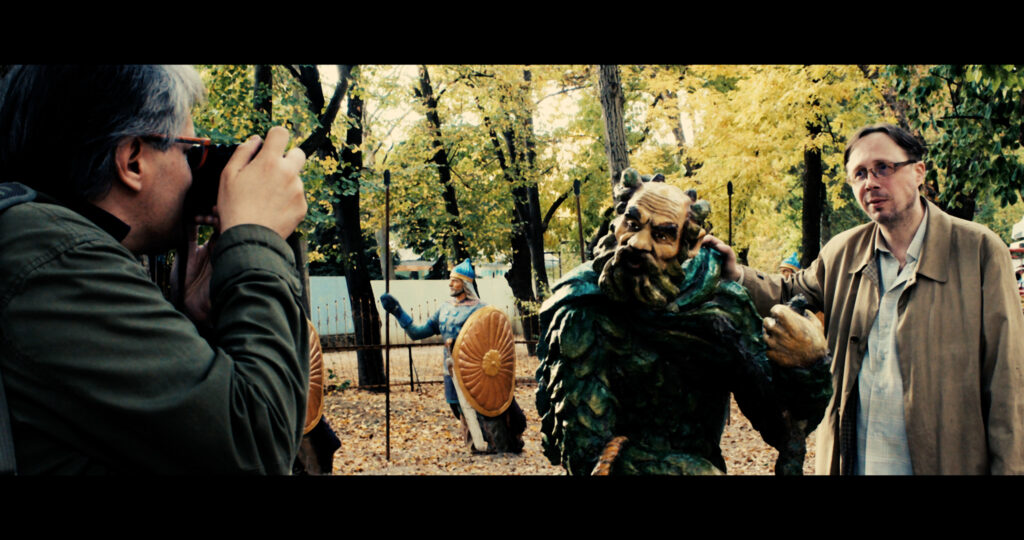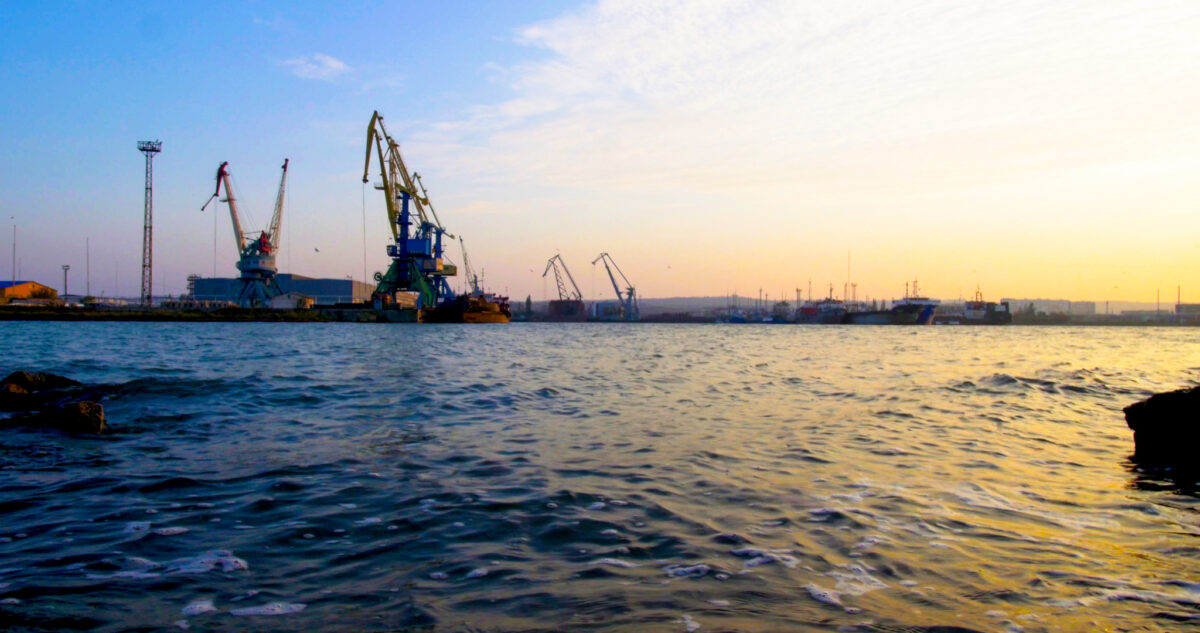The Research Project
Our project Behind Potemkin’s Villages: Crimea Between Art and Crisis emerged following the phenomenon of the so called Bosphorus-forum, a blend of arts festival and conference meeting. The Bosphorus-forum was supposed to be a counterpoint to the tensions in and considering Crimea after the peninsula found itself in the independent state of Ukraine. Since 1993, the meetings of the Bosphorus-forum have taken place every couple of years in Simferopol and in Kerch. They are meant as a dialogue platform for the peninsula’s artistic community and cultural professionals from all the sides that are at odds over its future – Russia, Ukraine and the Crimean Tatars. From the outset, these meetings have made space for collaborative conceptual actions, including land art and happenings which encouraged the public to take part.
The Essay Film
In our film we drew from three different cinematic methods to present our findings.
Observational Cinema, Cinema Vérité and the Essay film.
Observational Cinéma of the 50s and 60s popularized through Gregory Bateson and Margeret Mead, both Cultural Anthropolgists and filmmakers.
Tries to capture its protagonists in everyday life with minimal interference. Also in postproduction it minimalizes the editing processes, which is not coerced to tell coherent stories. It is comprised of wide angle static long-shots.
Another approach has evolved in the work of Jean Rouch and Edgar Morin. An influential example is their film Chronicle of a Summer from 1961 where they take an active part in their films, which are collaborative and try to give space to their protagonists. It is a more inclusive, active and responsive approach, which deploys different cinema techniques in recording aswell as editing, but also upholds to the extended sequence shot.
Both observational Cinéma and Cinéma Vérité can be understood as pushing in the same direction of non-fiction filmmaking with the purpose to give the viewer the illusion of authentic at-hand documentation where the voice-over commentary is employed as little as possible.
The third and last source of inspiration in our audio-visual work on the Bosphorus-Forum participants in Crimea stems from the Essay-Film. It is a genre that blurres the lines between fictional and non-fictional filmmaking. One of the most influential films in this genre is Sans Soleil of Chris Marker. The non-fictional footage is heavily edited in a stream of consciousness like style while held together with a superimposed fictional voic-over commentary.
The Research Project
Our project Behind Potemkin’s Villages: Crimea Between Art and Crisis emerged following the phenomenon of the so called Bosphorus-forum, a blend of arts festival and conference meeting. The Bosphorus-forum was supposed to be a counterpoint to the tensions in and considering Crimea after the peninsula found itself in the independent state of Ukraine. Since 1993, the meetings of the Bosphorus-forum have taken place every couple of years in Simferopol and in Kerch. They are meant as a dialogue platform for the peninsula’s artistic community and cultural professionals from all the sides that are at odds over its future – Russia, Ukraine and the Crimean Tatars. From the outset, these meetings have made space for collaborative conceptual actions, including land art and happenings which encouraged the public to take part.
To sum up our approach in dealing with audio-visual material we can say that we followed the lines of observational cinema during the recordings while engaging in a Vérité participatory Style with our Protagonists and worked in post-production within the framework of the essay-film a voice-over dialogue to bring forth some argumentation aswell as stream of consciousness.
In this regard we coin our approach as fictocritical. A term heavily used by the anthropologist Taussig, who claims that „Fictocriticism ist just a combination of storytelling and theory in unexpected ways. Plus fieldwork”.6 Initially comprised to characterize text based research we expand the concept to research with audio-visual material, while agreeing with H. Louis Flavell, an austrailian scientist that “Ficto-critical practice is concerned with interrogating the violence of representation, to legitimately explore what is inevitabely left out and or misrepresented through that process.”
The Interview Situation
The advantage of the interview situation is its openness in the performatively produced space for spontaneous thinking. The protagonists can develop their thoughts, think them until the end. While the intellectuals were talking and us actively listening and recording them, they have also formulated thoughts which they have not prepared in advance. By this, biography and work, creative process and the result could be brought together. Our interviewees could leave their private space and enter the public one with the option to decide how far they show themselves as artists and their work.
They could interrupt themselves and take on some started thoughts, like it was the case with Ian Shapiro . They could associate freely or show some self-discipline while conveying an illustrative story, like it happened with Alexander Barbuch, a friend of Andrei Poliakov and Igor Sid. They could use the conversation for presenting an interpretation of their biography in the way they wanted as for example Ismet Sheich-Zade did in explanations of his artistic works. Overall, in the situation of a dialogue Tatjana had the possibility to intervene as the interviewer, to reformulate the question, to agree or to contradict the interviewees. At the same time, Cyril has focused on the physical, the visual and the auditive impressions, spontaneously reacting to readings of poetry, unforeseen emotional outbreaks as well as such factors like the protagonists’ friends or policemen popping up, changing weather conditions, the light, the noise and also the silence.
One especially interesting moment emerged when we felt mirrored by our protagonist Andrei Poliakov. In the interview with the poet and philosopher we suddenly encountered the theoretical framework which we wanted to use for combining our different of fictional and factual material: He vividly referred to Cultural Semiotics, to the Crimean Text as well to a self-reflexive identity narration. The latter one also takes place in his philosophical poems and his poetic essays. à evtl. zitat von poliakov zur kultursemiotik einblenden/ihn dazu sprechen lassen (fand beim spaziergang in seinem bezirk statt, glaube ich)
An analysis in terms of the neutral language ofCultural Semiotics reads places as ‘texts’ and texts as platforms for meaning making, assuming that a text is in general a configuration of signs. Hence the semiotic notion of text covers intermedial formats like film, too. Semiotics of culture(s) involve both disciplines, Slavic literary studies and Anthropology, from which we come from: It is a theory developed by Eastern European scholars like Iuri Lotman as well as by Western anthropologists during the Writing Culture debate lead by George E. Marcus and James Clifford.
Representation Strategies (fact / fiction / hybridity)
Following the Writing Culture debate and the notion of semiospheric exchange of cultural signs, we have intentionally chosen blurred multimedia genres: The final outcomes consist of a documentary film Crossroads Crimea (ca. 70 minutes), a contextualising essay (ca. 170 pages) and a homepage with the video interviews where they are stored. While the documentary film amplifies the immediate intensity in portraits of people and places, the essay picks up the main issues of the film contextualising them within Crimea’s aesthetic, historic and political traditions and reflecting them from a perspective of polyphony and cultural hybridity. Our media formats for the outcomes seeks to be in accordance with the material: Both, the film and an accompanying book oscillate between observation and narration, analysis and aesthetics.
After the research visits the interviews were transcripted and translated from Russian to German. To some extend this process allowed to re-experience the research trip. The transcripts were partly useful for single chapters and quotations in the essay. Moreover, they helped to decide which parts will enter the essay-film.
During the montage and the writing up of the accompanying text Cyril and Tatjana have taken time out to work on the film resp. text separately. In the last stage we reunited and discussed the narratives, accents and the symbolic languages of both outcomes.
In our case, the documentary and the essay about the Bosphorus-forum research have become also part of the field, turning out to be inseparable from the Crimean text. Her essay allowed Tatjana to participate in the interviews more extensively, to utter all the statements, questions, irritations and doubts which emerged during the interaction with the protagonists. It also included reflections while travelling on the peninsula, popping up memories and moreover, an imaginative part of the Bosphorus-forum as a polyphonic dialog in general. The essay is her way of taking part in the dialogue with the interviewed persons. It gave her also space to self-interview her different parts as researcher, as interface between the interviewees and the camera, as author and as a culturally hybrid figure: a Crimean one, a German/Swiss one, a researcher and an artistic voice which resonated with searches for poetry several forum-participants talked about. During her conversations she was perceived in a peculiar variety of ways: as German, as Swiss, as Russian, as Crimean Tatarian, as a spy, as a krymtchanka, as naiv, as tough etc. People projected whatever they wanted. Probably this echoed in a way that the Western, Russian, Ukrainian and Turkish media also did project on Crimea whatever they wanted. Most importantly, writing about those research trips with a time and spacial distance provided her with the opportunity to feel the facets of cultural hybridity of Crimea and the narratives about the peninsula, of the protagonists and of herself.
One of the most striking statements of her essay is the reactivation of the idea of Geopoetics and the Bosphorus-forum despite their almost inactive status in the last years: May the forum be declared as dead, it still lives in the memories, activities and hopes of its participants. Natalia Azarova’s description of the Forum as a crazy idea “in spite of everything”, engaged with the people of Crimea, can be traced in Tatjana’s book, too. The text imagines chapter by chapter participants from Ukraine, Germany and Switzerland, like Serhii Zhadan, who denied Sid’s invitation, and all the intellectuals who reject ever visiting Crimea because they consider it as non-liberal to go there. In a postmodern manner the essay reactivates historic forums with their actions, adds portraits of the participants and suggestions for potential participants. It breaks with geopolitical borders, exclusions and stereotypes. In sum, the text continues the idea of geopoetics and the Bosphorus-forum by following its postponement onto better times – and by transforming them into a lasting text. Actually, our medium-edition consisting of a book and a video proposes a substitute to the almost stopped Forum activities, preventing the Bosphorus-forum from dying.
The documentary understands itself in the tradition of the essay film. It pushes the limits of scientific research towards a medial experiment and even towards fiction. Both, the documentary and the accompanying essay demonstrate the possibilities of interdisciplinary and trans-medial research.


